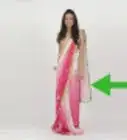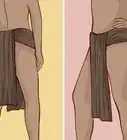This article was co-authored by wikiHow Staff. Our trained team of editors and researchers validate articles for accuracy and comprehensiveness. wikiHow's Content Management Team carefully monitors the work from our editorial staff to ensure that each article is backed by trusted research and meets our high quality standards.
There are 8 references cited in this article, which can be found at the bottom of the page.
This article has been viewed 459,723 times.
Learn more...
A pancha, or dhoti, is a traditional garment for men that’s worn in many countries, including Bangladesh, India, and Pakistan. It consists of a large rectangular piece of unstitched fabric that’s folded and knotted at the waist, then wrapped around the legs and hips. The dhoti is most often worn for special occasions, including weddings, religious worship, festivals, and for formal occasions. Because the pancha is just a large piece of cloth, it can be difficult to know how to wrap and tie it if you’ve never done it before.
Steps
Tying a Brahmin-Style Pancha Kachcham
-
1Position your material. There are different ways of wrapping and tying a dhoti, and Brahmins have a special variation of their own. To tie a Brahmin style dhoti, you make two folds in the back and one in the front.[1]
- To start, hold the fabric horizontally behind you. Make sure the colored bands are at the top (at your waist) and facing outward.
-
2Wrap the cloth around your waist. Wrap the fabric from the back to the front so that you're holding the material in front of your body. Arrange the cloth so that you have equal amounts of fabric on the right and left sides.
- With the material from the left side, pull the cloth taut and wrap it around your waist. Hold the cloth at your right hip, letting the excess drape down your side to the ground.
- Wrap the material from the right side around your waist and hold it at your left hip. Pull the material so it’s snug around your waist.
- At the waist, fold the material down by about an inch (2.5 cm). Then fold it again by another inch to hold it in place.[2]
Advertisement -
3Make the first folds. A defining characteristic of the dhoti is the accordion-style pleats, called kosuval, that you create by folding and tucking the cloth. To make the first fold:
- Pick up the top layer of material that’s hanging from your left hip.
- Hold the material straight out in front of you.
- Make a two- to four-inch (five- to 10-cm) vertical fold in the end of the material to fold the fabric back on itself toward your body.
- Make a second accordion-style fold in the material in the same way. Continue making folds like this until you’ve made about six accordion folds in the fabric.
- Tuck the top three or four inches (7.5 to 10 cm) of the folded material into the waistband of the cloth.[3]
-
4Make the second fold. Lean down and pick up the bottom corner of the material you just folded in to your waistband. Smooth out the fabric so it isn't twisted. Orient the fabric so the decorative band running at the very edge of the horizontal border of the material is vertical in front of you.[4]
- Make six vertical accordion folds in the end of the material, folding the fabric back toward your body as before.
- Tuck the top three or four inches (7.5 to 10 cm) of the folded material into the waistband of the cloth, on top of the first fold.[5]
-
5Make the third fold. Lift up the layers of material that you just folded and tucked in to your waistband, so you can access the loose material at the right side of your body. Pull the material out in front of you. Let go of the material that you already folded and tucked in.
- Hold the material from the right side of your body in front of you. Smooth it out so it isn't twisted or bunched up.
- Hold the corner of the fabric and orient it so the decorative band on the horizontal edge is vertical in front of you.
- Make about 10 accordion folds in the fabric, until you have folded the entire vertical panel of fabric.
- Flatten and smooth out the material so the folds are neat and straight.[6]
-
6Tuck the final fold. The final fold gets tucked into the back of the waistband. Bring the folded material through your legs, making sure to go underneath the rest of the cloth.
- Grab the folded material from the back and pull it out so it’s over the top of the cloth wrapped around your waist. Make sure the material hasn’t become twisted.
- Bring the top of the folds to your waist and tuck the top three or four inches (7.5 to 10 cm) of the fold into the waistband of the cloth.[7]
- The fabric going between your legs should be snug, but not tight or painful.
Wearing a Vrindavan-Style Pancha Kachcham
-
1Position the fabric. The Vrindavan-style is another way of wrapping, tying, and folding the pancha kachcham. It’s often the method used by members of the Hare Krishna.
- Hold the fabric horizontally behind you.
- Wrap the fabric around your hips and waist, and bring it to the front of your body.
- Adjust the fabric so you have equal amounts of fabric on the right and left sides.[8]
-
2Tie a knot to keep the fabric in place. Pull the fabric taut around your body. Hold the fabric so that you’ve got just enough to wrap around your body. At your navel, tie a knot in the fabric.
- Let the rest of the fabric hang loose in front of you.[9]
-
3Make the back fold. Grab the fabric from the left side. Holding the top left corner of the fabric, reach down and grab the bottom left corner. Let go of the top corner.
- Make four-inch (10-cm) accordion pleats in the fabric.
- Fold the material back toward the top left corner, so that you fold the entire vertical panel of the fabric back on itself.
-
4Tuck the fold into your waist at the back. Hold on to the folded fabric so the folds don’t come undone. Pull the material through your legs, making sure to go under the fabric behind your legs.
- Tuck the top four inches (10 cm) of the folded fabric into the waistband of the fabric at the center of your back.[10]
-
5Make the front fold. Grab the fabric on the right side of the knot. Hold the top right corner of the material. Make about six vertical accordion pleats in the fabric, so that you're folding the material back on itself toward your body.
- Center the folded material at your waist and tuck the top four inches into the waistband of the fabric.[11]
-
6Tuck in the pleated material again for extra decoration. Grab the first two layers of material from the pleated fabric at your front. Hold the layers at the height of your upper thigh. Fold the material up toward your waist and tuck a few inches into the waistband.
- When you tuck in the extra fold, tuck it in slightly off-centre, to the left of the original fold.[12]
When and How to Wear the Pancha Kachcham
-
1Learn the different names for the pancha kachcham. The pancha kachcham has many different names in different regions of the world. You may know it as the dhoti, but other people may call it something different. Knowing the many names may help you identify how and when to wear the garment. The pancha kachcham is also called:[13]
- Lacha (Punjabi)
- Dhoti (Bengali)
- Panache (Kannada)
- Veshti (Tamil)
- Pancha (Telugu)
- Mundu or veshti (Malayalam)
- Dhoti (Marathi)
-
2Pick the right color. The dhoti comes in many colors, and the most common are white, cream, black, saffron, and blue. In general, white and cream dhotis are always safe to wear. You shouldn’t wear the pancha kachcham in other colors unless:[14]
- You’re a pilgrim visiting Sabarimala. Wear a black or navy dhoti for this purpose.
- You're an ascetic or Hare Krishna. Wear a saffron dhoti to signify this.
-
3Know when to wear the dhoti. There are several occasions when it’s appropriate to wear the pancha kachcham. Some of the most important times to wear a dhoti are at weddings and for temple.
-
4Pair the dhoti with the right garments. The dhoti isn't always worn on its own, and different regions have different customs about what else you should wear it with.
- In northern India, the pancha kachcham is often worn with the kurta, which is a type of collarless shirt.[17]
- In the south of India, the dhoti is often paired with the Angavastram or the chokka, which are both unstitched pieces of cloth. The angavastram and chokka get draped over the shoulders.[18]
- It’s not necessary to wear undergarments with it. The dhoti is popular in hot climates, so it’s important to keep cool by wearing fewer layers.[19]
Community Q&A
-
QuestionWhat is the style of dhoti applicable to bachelors?
 Community AnswerIf the dhoti is "double" (8 or 10 yards), then you must make a single folding so that it becomes exactly half of its full length and its original ends come together. If it is "single," no folding is required. Wrap it around your waist, leaving equal length at both sides but ensuring that the original end portions are on your left side and the folded end on the right. Bring the right portion up to your extreme left and tuck it there tightly. Then take the left portion over the right one and bring it up to the right end and insert it there tightly.
Community AnswerIf the dhoti is "double" (8 or 10 yards), then you must make a single folding so that it becomes exactly half of its full length and its original ends come together. If it is "single," no folding is required. Wrap it around your waist, leaving equal length at both sides but ensuring that the original end portions are on your left side and the folded end on the right. Bring the right portion up to your extreme left and tuck it there tightly. Then take the left portion over the right one and bring it up to the right end and insert it there tightly. -
QuestionHow do I go to the washroom in dhoti, do I have to remove it?
 Community AnswerNo, you just fold it on your knees.
Community AnswerNo, you just fold it on your knees. -
QuestionDo I need to wear shorts when wearing dhoti?
 Community AnswerNot necessarily, but that is the best way to prevent yourself from a wardrobe malfunction. Wear a short that isn't visible when the dhoti is on and choose a light colored short.
Community AnswerNot necessarily, but that is the best way to prevent yourself from a wardrobe malfunction. Wear a short that isn't visible when the dhoti is on and choose a light colored short.
References
- ↑ https://www.youtube.com/watch?v=qwfeFdDXqfw
- ↑ http://www.tiehow.com/how-to-tie-a-dhoti/
- ↑ https://www.youtube.com/watch?v=qwfeFdDXqfw
- ↑ https://www.youtube.com/watch?v=qwfeFdDXqfw
- ↑ http://www.tiehow.com/how-to-tie-a-dhoti/
- ↑ http://www.tiehow.com/how-to-tie-a-dhoti/
- ↑ https://www.youtube.com/watch?v=qwfeFdDXqfw
- ↑ https://www.youtube.com/watch?v=fDTGvfWflCE
- ↑ https://www.youtube.com/watch?v=HbB1Z0CLXn0
- ↑ https://www.youtube.com/watch?v=fDTGvfWflCE
- ↑ https://www.youtube.com/watch?v=HbB1Z0CLXn0
- ↑ https://www.youtube.com/watch?v=fDTGvfWflCE
- ↑ http://www.culturalindia.net/indian-clothing/dhoti.html
- ↑ https://ramanan50.wordpress.com/2012/03/13/how-to-wear-a-dhoti-indian-pancha-kacha-and-regular-style-videos/
- ↑ http://www.tiehow.com/how-to-tie-a-dhoti/
- ↑ http://www.culturalindia.net/indian-clothing/dhoti.html
- ↑ http://www.ebay.com/gds/How-to-Wear-the-Dhoti-in-Tamil-Nadu-Style-/10000000205608782/g.html
- ↑ http://www.culturalindia.net/indian-clothing/dhoti.html
- ↑ http://www.indianmirror.com/culture/clothing/dhoti.html
About This Article
To wear a pancha kachcham, start by holding the fabric horizontally behind you with the colored bands at the top facing outwards. Wrap the pancha around your waist so equal amounts of fabric are on the right and left and pull it until its snug. Fold the material down 1 inch, then fold it down another 1 inch to hold it in place. Next, take the top layer of the material that’s hanging from your left hip and make six 2-inch vertical folds at the end of the material. Tuck the top 4 inches of fabric into your waistband. Make 6 more vertical accordion folds in the bottom corner of the material, then tuck the top few inches into your waistband as well. Make about 10 more folds in the loose material on the right side of your body. Finally, gather the loose material from the back and tuck it into the back of your waistband. For more tips, including how to wear a Vrindavan-style pancha, read on!
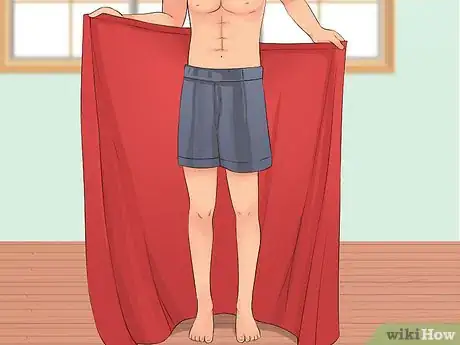
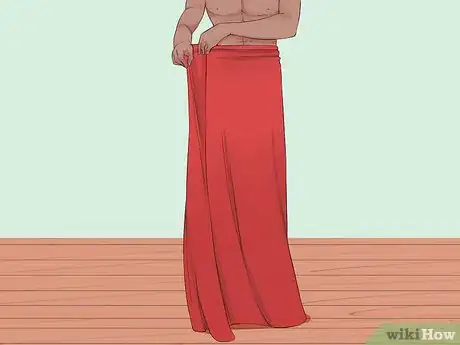
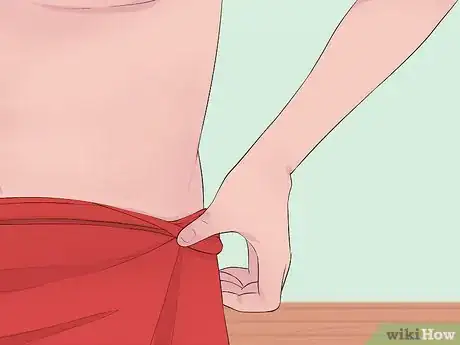
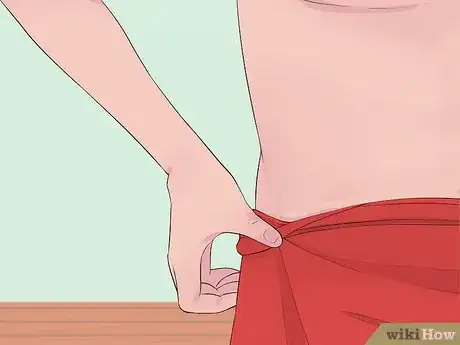
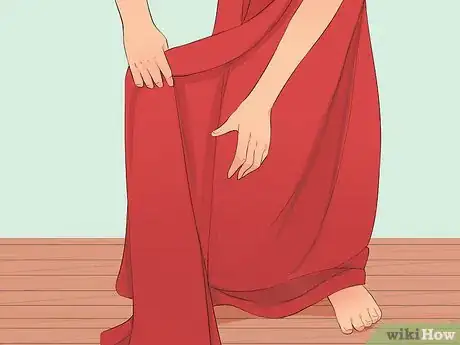
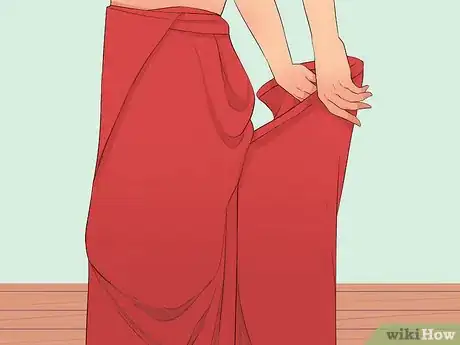
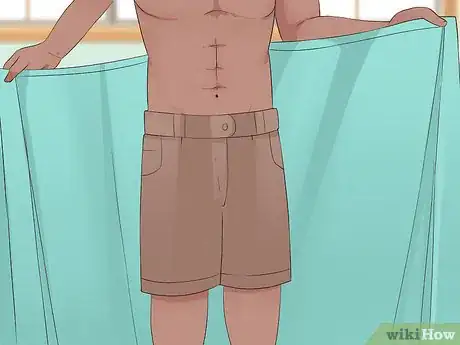
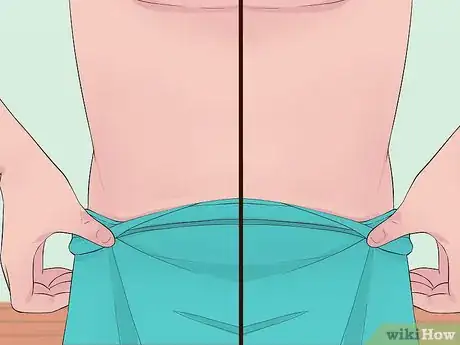
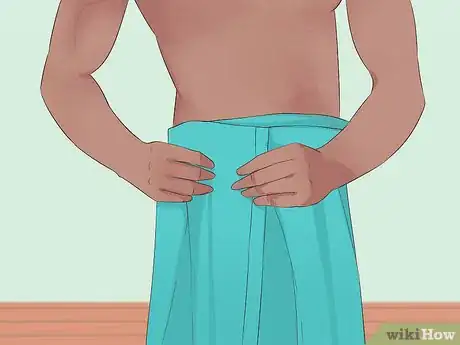
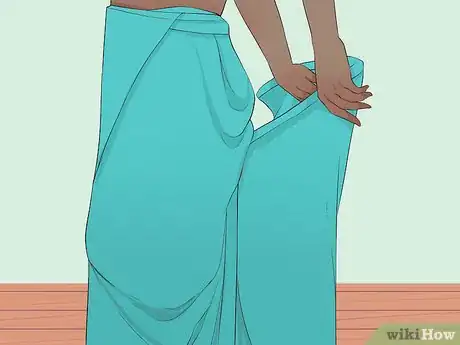
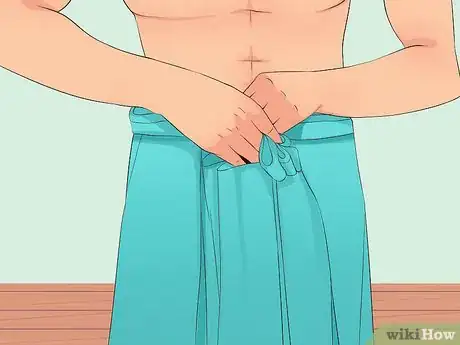
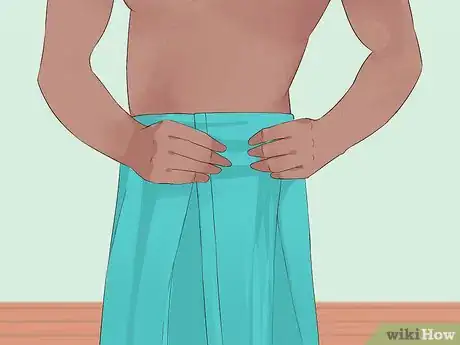
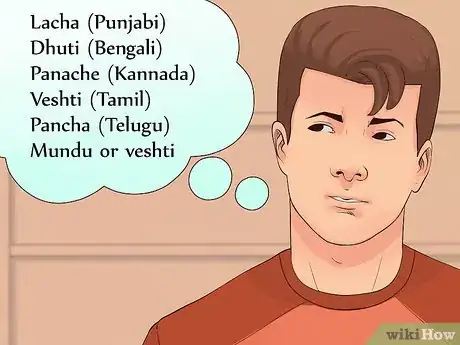
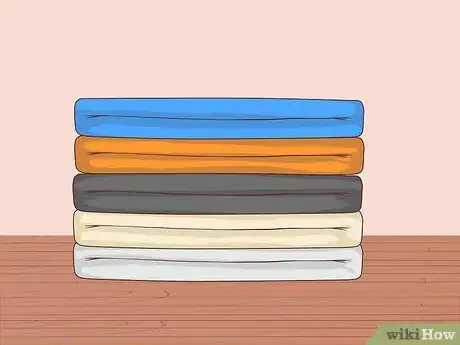
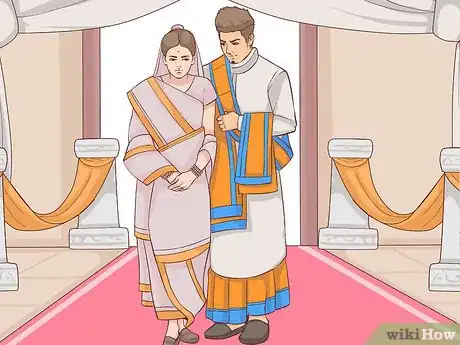
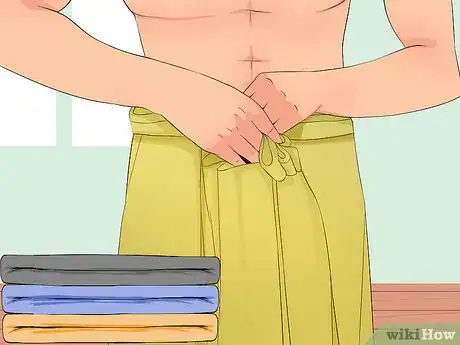
-Step-5.webp)



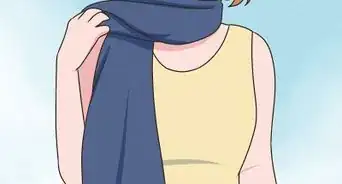



-Step-13.webp)







-Step-5.webp)
